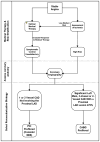Revascularization for coronary artery disease in diabetes mellitus: angioplasty, stents and coronary artery bypass grafting - PubMed (original) (raw)
Review
Revascularization for coronary artery disease in diabetes mellitus: angioplasty, stents and coronary artery bypass grafting
Doron Aronson et al. Rev Endocr Metab Disord. 2010 Mar.
Abstract
Patients with diabetes mellitus (DM) are prone to a diffuse and rapidly progressive form of atherosclerosis, which increases their likelihood of requiring revascularization. However, the unique pathophysiology of atherosclerosis in patients with DM modifies the response to arterial injury, with profound clinical consequences for patients undergoing percutaneous coronary intervention (PCI). Multiple studies have shown that DM is a strong risk factor for restenosis following successful balloon angioplasty or coronary stenting, with greater need for repeat revascularization and inferior clinical outcomes. Early data suggest that drug eluting stents reduce restenosis rates and the need for repeat revascularization irrespective of the diabetic state and with no significant reduction in hard clinical endpoints such as myocardial infarction and mortality. For many patients with 1- or 2-vessel coronary artery disease, there is little prognostic benefit from any intervention over optimal medical therapy. PCI with drug-eluting or bare metal stents is appropriate for patients who remain symptomatic with medical therapy. However, selection of the optimal myocardial revascularization strategy for patients with DM and multivessel coronary artery disease is crucial. Randomized trials comparing multivessel PCI with balloon angioplasty or bare metal stents to coronary artery bypass grafting (CABG) consistently demonstrated the superiority of CABG in patients with treated DM. In the setting of diabetes CABG had greater survival, fewer recurrent infarctions or need for re-intervention. Limited data suggests that CABG is superior to multivessel PCI even when drug-eluting stents are used. Several ongoing randomized trials are evaluating the long-term comparative efficacy of PCI with drug-eluting stents and CABG in patients with DM. Only further study will continue to unravel the mechanisms at play and optimal therapy in the face of the profoundly virulent atherosclerotic potential that accompanies diabetes mellitus.
Figures
Fig. 1
Revascularization strategy in patients with diabetes with stable angina
Similar articles
- Randomized comparison of percutaneous coronary intervention with coronary artery bypass grafting in diabetic patients. 1-year results of the CARDia (Coronary Artery Revascularization in Diabetes) trial.
Kapur A, Hall RJ, Malik IS, Qureshi AC, Butts J, de Belder M, Baumbach A, Angelini G, de Belder A, Oldroyd KG, Flather M, Roughton M, Nihoyannopoulos P, Bagger JP, Morgan K, Beatt KJ. Kapur A, et al. J Am Coll Cardiol. 2010 Feb 2;55(5):432-40. doi: 10.1016/j.jacc.2009.10.014. J Am Coll Cardiol. 2010. PMID: 20117456 Clinical Trial. - Outcomes with coronary artery bypass graft surgery versus percutaneous coronary intervention for patients with diabetes mellitus: can newer generation drug-eluting stents bridge the gap?
Bangalore S, Toklu B, Feit F. Bangalore S, et al. Circ Cardiovasc Interv. 2014 Aug;7(4):518-25. doi: 10.1161/CIRCINTERVENTIONS.114.001346. Epub 2014 Jun 17. Circ Cardiovasc Interv. 2014. PMID: 24939927 - Stroke Rates Following Surgical Versus Percutaneous Coronary Revascularization.
Head SJ, Milojevic M, Daemen J, Ahn JM, Boersma E, Christiansen EH, Domanski MJ, Farkouh ME, Flather M, Fuster V, Hlatky MA, Holm NR, Hueb WA, Kamalesh M, Kim YH, Mäkikallio T, Mohr FW, Papageorgiou G, Park SJ, Rodriguez AE, Sabik JF 3rd, Stables RH, Stone GW, Serruys PW, Kappetein AP. Head SJ, et al. J Am Coll Cardiol. 2018 Jul 24;72(4):386-398. doi: 10.1016/j.jacc.2018.04.071. J Am Coll Cardiol. 2018. PMID: 30025574 - Diabetes and coronary revascularization.
Flaherty JD, Davidson CJ. Flaherty JD, et al. JAMA. 2005 Mar 23;293(12):1501-8. doi: 10.1001/jama.293.12.1501. JAMA. 2005. PMID: 15784875 Review.
Cited by
- MicroRNAs as Biomarkers for Coronary Artery Disease Related to Type 2 Diabetes Mellitus-From Pathogenesis to Potential Clinical Application.
Szydełko J, Matyjaszek-Matuszek B. Szydełko J, et al. Int J Mol Sci. 2022 Dec 29;24(1):616. doi: 10.3390/ijms24010616. Int J Mol Sci. 2022. PMID: 36614057 Free PMC article. Review. - Short-term dual antiplatelet therapy in diabetic patients admitted for acute coronary syndrome treated with a new-generation drug-eluting stent.
Vranken NPA, Rasoul S, Luijkx JJP, Pustjens TFS, Postma S, Kolkman EJ, Kedhi E, Rifqi S, Lee MKY, Ebelt H, Merkely B, Verdoia M, Wojakowski W, van 't Hof AAWJ, Suryapranata H, De Luca G. Vranken NPA, et al. Diabetes Metab Res Rev. 2022 Jul;38(5):e3530. doi: 10.1002/dmrr.3530. Epub 2022 Apr 22. Diabetes Metab Res Rev. 2022. PMID: 35395144 Free PMC article. Clinical Trial. - Diabetes and restenosis.
Wilson S, Mone P, Kansakar U, Jankauskas SS, Donkor K, Adebayo A, Varzideh F, Eacobacci M, Gambardella J, Lombardi A, Santulli G. Wilson S, et al. Cardiovasc Diabetol. 2022 Feb 14;21(1):23. doi: 10.1186/s12933-022-01460-5. Cardiovasc Diabetol. 2022. PMID: 35164744 Free PMC article. Review. - Coronary artery disease and diabetes mellitus.
Aronson D, Edelman ER. Aronson D, et al. Cardiol Clin. 2014 Aug;32(3):439-55. doi: 10.1016/j.ccl.2014.04.001. Epub 2014 Jun 10. Cardiol Clin. 2014. PMID: 25091969 Free PMC article. Review. - Functional differences between healthy and diabetic endothelial cells on topographical cues.
Cutiongco MFA, Chua BMX, Neo DJH, Rizwan M, Yim EKF. Cutiongco MFA, et al. Biomaterials. 2018 Jan;153:70-84. doi: 10.1016/j.biomaterials.2017.10.037. Epub 2017 Oct 25. Biomaterials. 2018. PMID: 29125983 Free PMC article.
References
- Luscher TF, Creager MA, Beckman JA, Cosentino F. Diabetes and vascular disease: pathophysiology, clinical consequences, and medical therapy: Part II. Circulation. 2003;108:1655–61. - PubMed
- Haffner SM, Lehto S, Ronnemaa T, Pyorala K, Laakso M. Mortality from coronary heart disease in subjects with type 2 diabetes and in nondiabetic subjects with and without prior myocardial infarction. N Engl J Med. 1998;339:229–34. - PubMed
- Aronson D, Rayfield EJ, Chesebro JH. Mechanisms determining course and outcome of diabetic patients who have had acute myocardial infarction. Ann Intern Med. 1997;126:296–306. - PubMed
- Hasdai D, Granger CB, Srivatsa SS, Criger DA, Ellis SG, Califf RM, et al. Diabetes mellitus and outcome after primary coronary angioplasty for acute myocardial infarction: lessons from the GUSTO-IIb Angioplasty Substudy. Global Use of Strategies to Open Occluded Arteries in Acute Coronary Syndromes. J Am Coll Cardiol. 2000;35:1502–12. - PubMed
Publication types
MeSH terms
LinkOut - more resources
Full Text Sources
Other Literature Sources
Medical
Miscellaneous
